After he was booted from his white-on-white-on-white loft when the Bozza Mansion was torn down, John Cage kind of drifted for a while. Apparently it was hard to find a good deal on a great space in Manhattan in 1954 [when you had no money.]
So for a while, Cage moved to The Land, one of the names for the pseudo-commune/art colony started by Paul & Vera Williams on 116 acres in Stony Point, Rockland County, NY. Paul was an architect friend of Cage’s from Black Mountain College, and he’d purchased the property after inheriting some money.
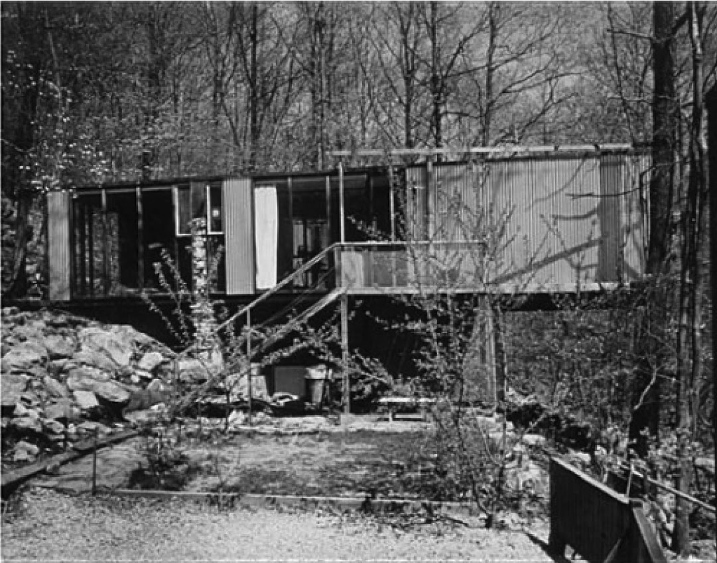
I don’t know why, but I’d always assumed Cage and the other The Land folks lived in little cottages. Not quite. It turns out Williams, a student of Breuer, created some classically modernist boxes.
The first pictures I’ve ever seen are in Brendan W. Joseph’s 2016 book, Experimentations: John Cage in Music, Art, and Architecture, which goes into some detail on the development of The Land and its surprising impact on Cage and his work.
Cage shared a building, a duplex, with the Williamses. He lived in 1 or 2 rooms on the left in the image above, separated by a stone wall he and Vera built. It looks quite nice, if simple, a bit like the Black Mountain College buildings everyone built together. Indeed, from Joseph’s account, it sounds like Williams was hoping to recapture some of that BMC mojo with his co-op experiment.
Category: art
Night In Front Of The Museum
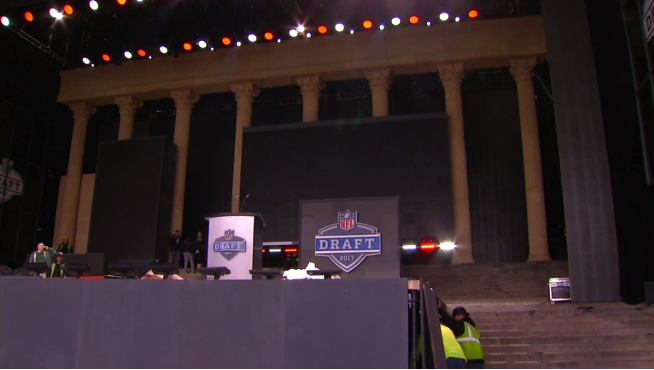
The NFL Draft is being held tonight at the top of The Rocky Steps. Which is another name for the courtyard of the Philadelphia Museum of Art. Which has a giant Greek temple facade. But which apparently didn’t work for the NFL folks’ shot, so they built a replica of a piece of the museum facade into their set, in front of the museum.
I just finished reading some Sturtevant repetition and simulacrum a few minutes ago, and there’s surely plenty to say about mediated images in circulation. But I think the real takeaway here is the NFL’s Sforzian backdrop lighting game is flabby and weak.
THEY BUILT A FAKE ART MUSEUM ON THE NFL DRAFT STAGE IN FRONT OF THE ACTUAL PHILLY ART MUSEUM [csnphilly, h/t @briansholis]
Untitled (I Can See Russia From My House), 2017

Installation shot: Untitled (I Can See Russia From My House), 2017, 15′ x 10′ x 6′, dye sublimation printed carpet, bolts, washers, lumber.
I’m psyched to announce the public installation of a new work, Untitled (I Can See Russia From My House), in Warrenton, Virginia. It is a dye sublimation print on carpet, mounted on a wood support.
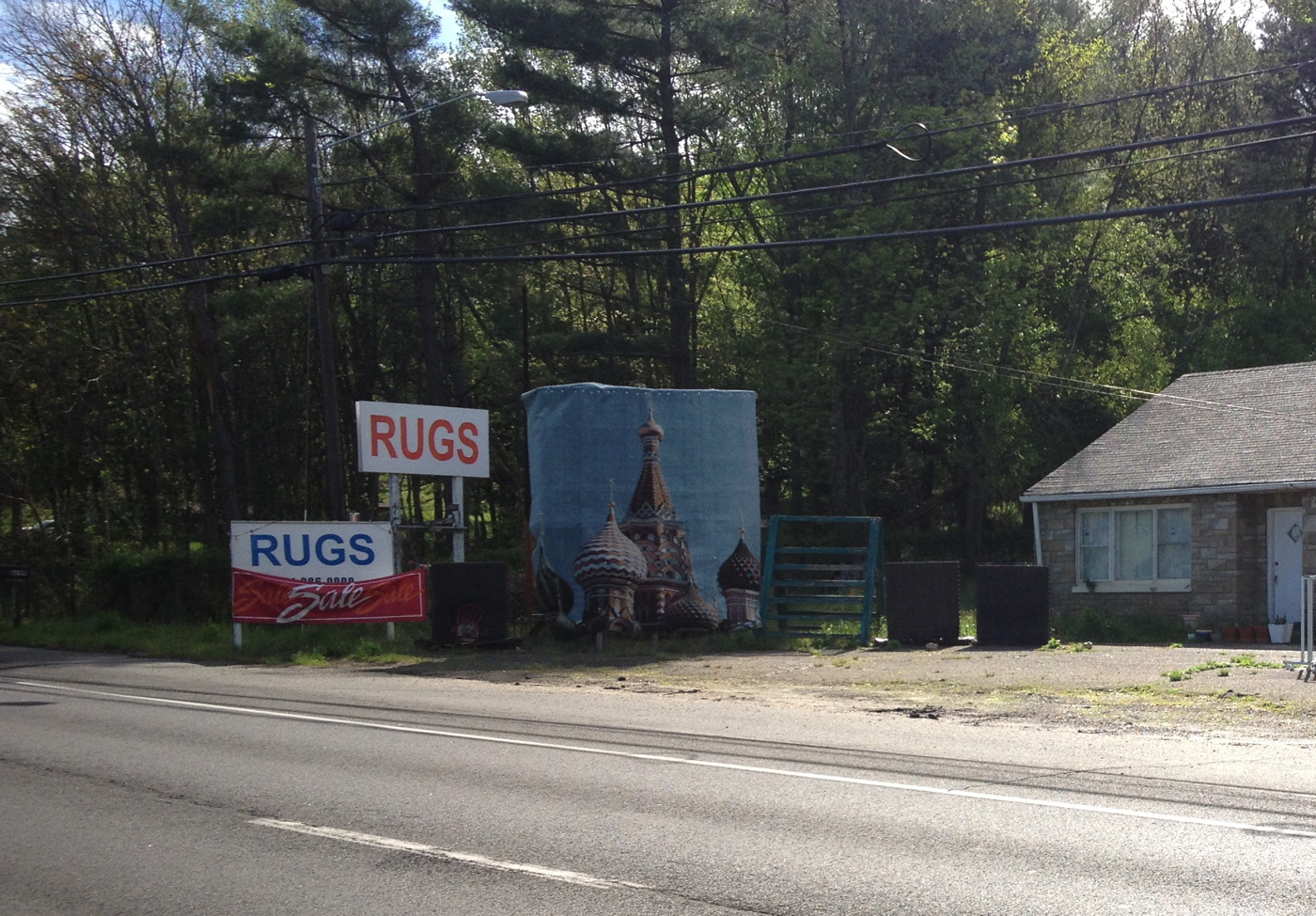
I suppose it could also be installed indoors, but it would lose a lot of the impact; it really is a piece that is best come upon in the course of daily life.

Untitled (I Can See Russia From My House), 2017, washer and bolt installation detail
The carpet is affixed to the support using bolts and washers [above]. Longtime Kremlin watchers will note that the image, of the south facade of St. Basil’s Cathedral, is here reversed.

Although an installation shot from December 2016 shows unrelated works installed nearby. It is the artist’s intention that this piece be viewed and appreciated on its own. Despite what you might assume, it is currently not for sale.
Better Read #013: Modern Art Shackled To Communism, by Congressman George Dondero
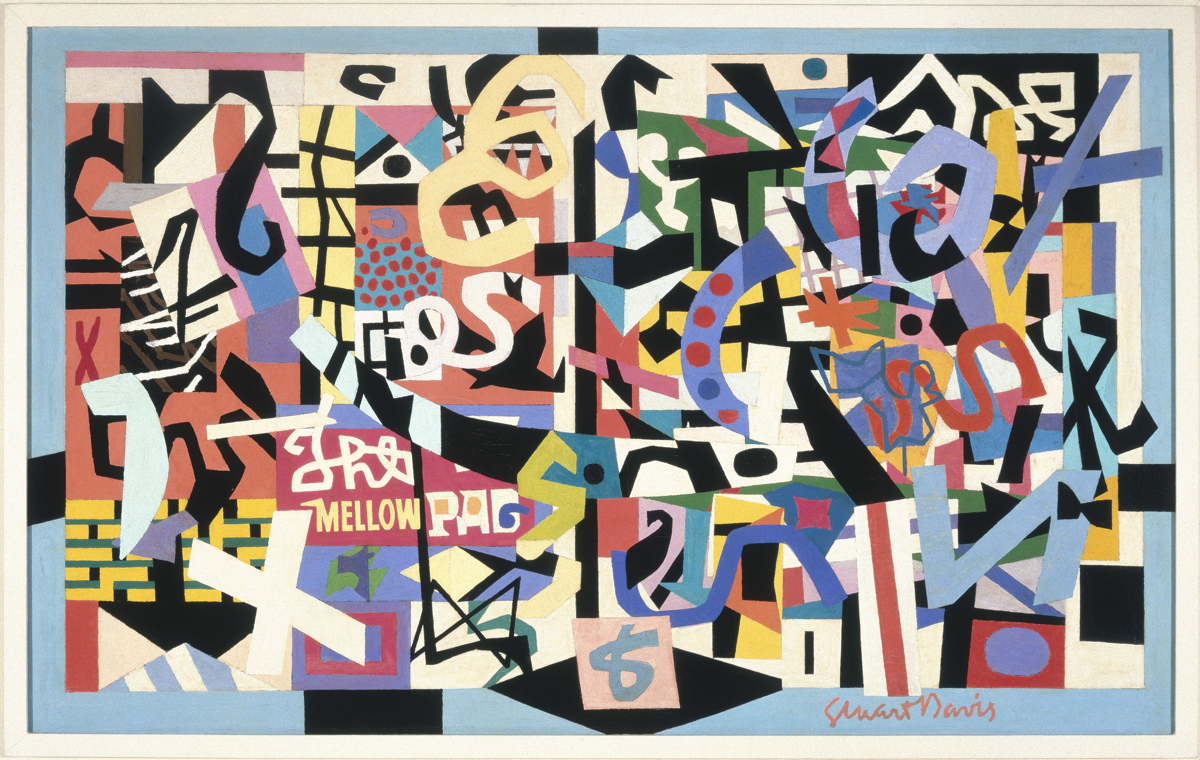
The Mellow Pad, 1945-51, by Stuart Davis, co-founder of the American Artists Congress in 1936, image: whitney.org
This edition of Better Read features a speech delivered by Michigan Republican congressman George Donderos on the House floor on Tuesday August 16, 1949 titled, “Modern Art Shackled To Communism.” I came across quotes and excerpts from this speech while researching the American Artists Congress, the group that brought Picasso’s Guernica to the United States for a fundraising tour in 1938.
Dondero made several fiery speeches against modern art during this, the McCarthy era, repeatedly accusing modernism and all its subsidiary “isms” of being a vile foreign-led Communist plot to destroy American art and values.
Near as I can tell, this is the first time Dondero’s complete speech has been available outside the Congressional Record, which turns out to be a lot harder to get ahold of than I expected. I am currently preparing a compilation of all Dondero’s art-related speeches, and the responses they engendered from the accused, the threatened, and even, surprisingly, the nominally allied. Because even I have a hard time listening to a robot for 26 minutes, the complete text of Dondero’s speech is included after the jump.
Download Better_Read_013_Dondero_Communist_Shackles_20170417.mp3 [26:49, 39mb, mp3 via dropbox greg.org]
Continue reading “Better Read #013: Modern Art Shackled To Communism, by Congressman George Dondero”
Remember, Remember, The Grift Of November
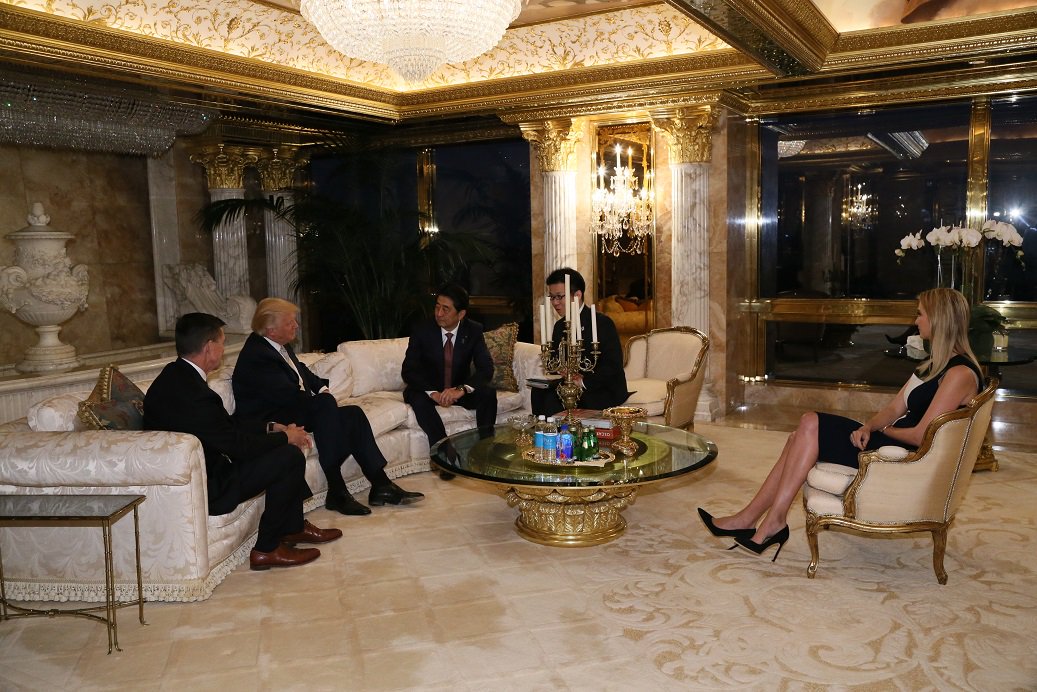
The first draft of history. History written by the victors What even is it? The barrage of nonsense comes so fast and thick and is so full of bullshit that the very notion of history feels out of date. Which is probably someone’s point. Or at the very least, in someone’s immediate interest.
Do you even remember the outrage when the Japanese Prime Minister’s Press Office released publicity photos of Shinzo Abe meeting Donald Trump at Trump Tower on November 17th, which revealed that Ivanka and Jared were sitting in on the meeting?
And then like two weeks later, the Times kind of buried the lede that at that very moment, Ivanka’s fashion label was negotiating a licensing deal with a Japanese apparel conglomerate whose majority shareholder is a development bank owned by the Japanese government.
Oh, hands were wrung, potential conflicts of interest were ruminated upon, denials and assurances were floated. And it all turned out to be bullshit, and that was also the same time Jared and Ivanka were in fact preparing to take up offices and jobs in the White House.
So maybe that’s a power of a painting: the ability to slow things down, even just long enough to have an impact, to make something stick, to give some context. It rewards the exercise of looking, looking longer, and looking back.
Campaign Ends April 26th: Our Guernica, After Our Picasso: A Kickstarter
Our Guernica, After Our Picasso: A Kickstarter
I’m not saying we should commission GWB to paint this, but I’m not saying we shouldn’t [deleted twitter url to a pic of angela merkel giving side-eye to ivanka trump at a white house mtg]
— gregorg (@gregorg) March 17, 2017
I swear, I tried not to do it, but the image was too strong. In the days since I started drafting this Kickstarter campaign, I quit several times. And then history kept catching up to this image. In fact, history started lapping it.
So yes, we need to mark this moment, this look on Chancellor Merkel’s face, on all our faces, when it was still possible to not believe what was happening before our eyes. And there’s only one painter who can do this moment justice. Unfortunately, he and justice are not really in a great spot right now, so we’re gonna use #chinesepaintmill and the Thomas Kinkade Editions Pyramid.
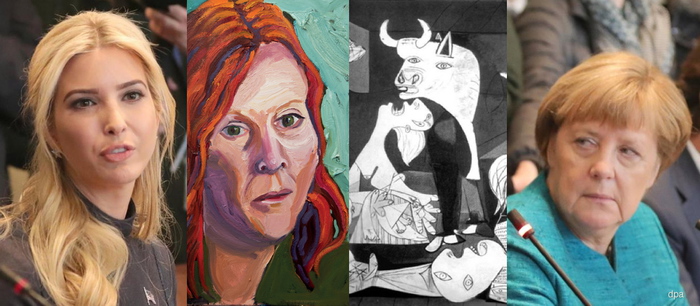
Our Guernica, After Our Picasso: collaged details from Michael Kappe/dpa photo, George W. Bush painting, and Picasso’s Guernica
In my darker moods, I imagine a series of paintings of such moments will come- Angelus Novus looking back and piling JPG upon JPG at his feet as the storm irresistibly propels us into the future. Can our brush-wielding Chinese allies capture the essence of Trumpian corruption with authentic Bushian flourish? Can we spread the resulting image(s) to the four corners of the warming, flooding earth to bear adequate witness? Let’s start with one and see.
Back “Our Guernica, After Our Picasso on Kickstarter now
UPDATE #1 After just a couple of days the project has gotten over halfway to its funding goal, thanks!
It has also been the subject of reportage by Will Fenstermaker at Artspace [who is also a backer, write what you know!] and AFC [“that’s a lot of layers to unpack for what’s essentially a meme” I do not disagree!]
On the more depressing news front, today, Day 3, might pass without a single new backer. Perhaps everyone’s too stunned at the floating of #Ivanka2024 by The Daily Caller [not linkin’, look it up], and worrying how a painting can somehow head off this meta-disaster. It probably can’t, but there’s a lot to be done in the mean time.
I’ve also noticed that backers are a savvy bunch. Folks seem to prefer the lower-priced, smaller prints at this stage. Possibly, I thought, because you’re reluctant to put up larger amounts of money for an artwork that you’ve 1) not seen because 2) it doesn’t exist yet.
It might be useful to reframe the entire project as a single conceptual piece, in which case, the physical manifestations are secondary to its core expression. But it’s still natural to wonder how it’ll look, especially if you’re contemplating getting a big one. I’m trying to think up a solution for this. Any advice or thoughts are welcome. And thanks again for spreading the word!
UPDATE #2 WHOA IT IS HAPPENING, THANKS! THE BALL IS ROLLING, THE CAMPAIGN IS CONTINUING. LET’S BUILD THAT PYRAMID AND LAUNCH A WHOLE BUSHMASTER CYCLE OF PAINTINGS TO DOCUMENT THIS THING!
Destroyed On Kawara Paintings
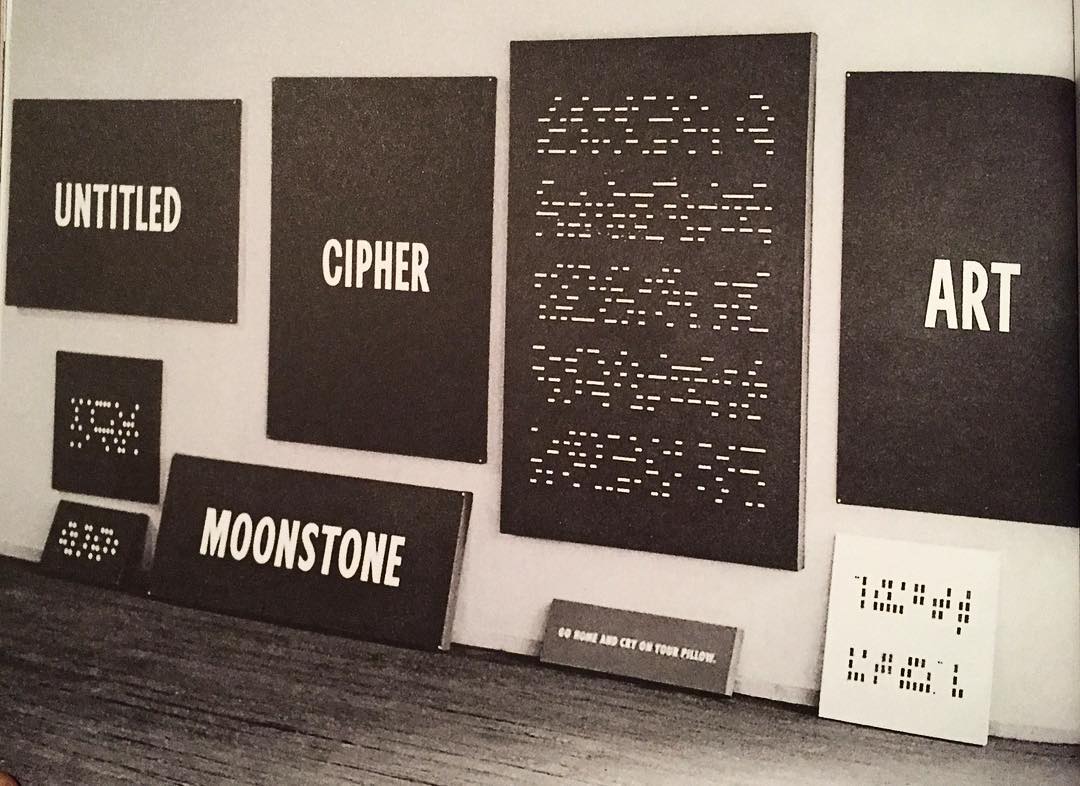
In 1965, before he figured out his Today Series date paintings, On Kawara experimented with several other types of paintings about language, text, and information. They contained a word or phrase, or a graphically encoded text. The National Gallery has a triptych, Title, that weren’t, but most of them were destroyed. [image from the Guggenheim’s exhibition catalogue via ig/mondoblogo]
Untitled (Newport Center Monument), 2017
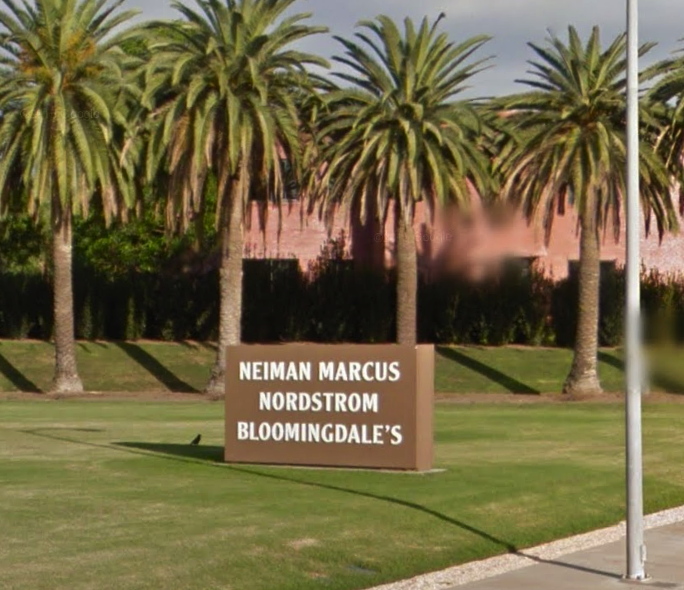
Untitled (Newport Center Monument) IV, 2017, 72 or 84-in. x 108 or 156 in. by 12 in., Ruddy Oak and Bright White on panels, installation image: gmaps
In 2011 The Irvine Company installed two identical monument signs in the grassy quarter-rounds on the East Coast Highway entrance of Fashion Island and Newport Center. They feature the names of three major tenants each, on both sides. Seven feet tall and 13 feet wide, they exceed the maximum dimensions (6′ x 9′) permitted under the Sign Standards of the Newport Beach Zoning Code, and required a variance. [In person the other day, I would never have guessed they were 7×13; they definitely feel like 6×9. Is it possible they were reduced in size after the permit was granted?]
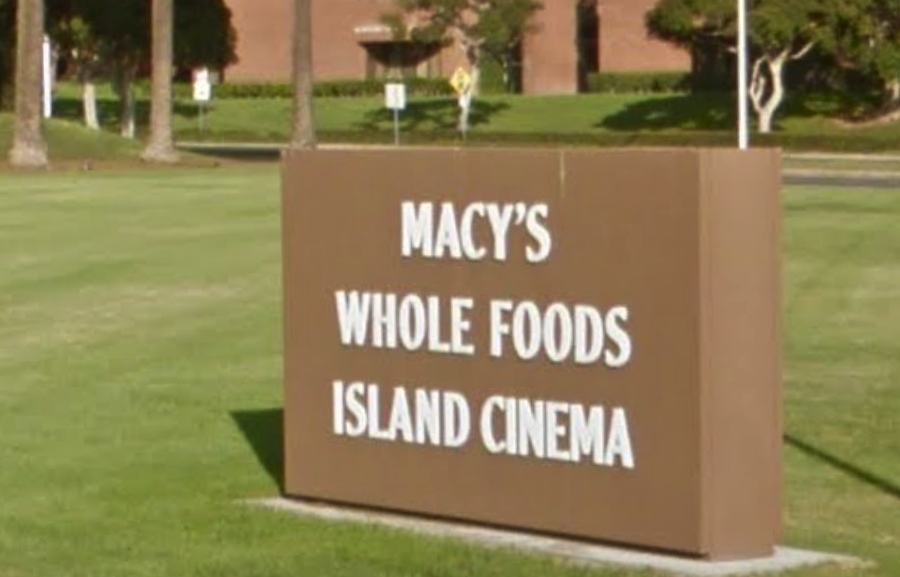
Untitled (Newport Center Monument) III, 2017, 72 or 84-in. x 108 or 156 in. by 12 in., Ruddy Oak and Bright White on panels, installation image: gmaps
Though they also exceed the Code’s letter size limits, the signs comply with the requirement that letters be “individually fabricated” and of high contrast for easy legibility. At least at their genesis, they were specified to be finished with Reflective Coating #1460 Bright White from Axon Aerospace, Inc.
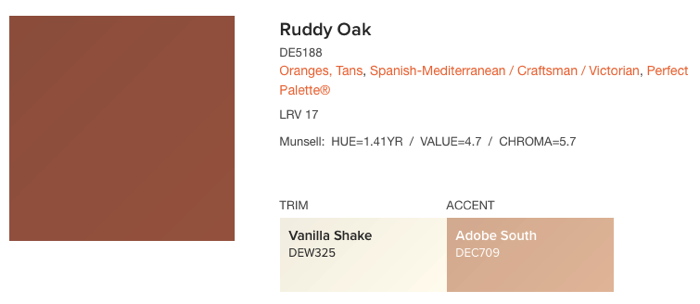
No aesthetic delectation here, Ruddy Oak! hashtag Spanish-Mediterranean, hashtag Craftsman, hashtag Perfect Palette®, image: dunnedwards.com
The 2011 permit application [pdf] describes the new signs as having “a faux plaster finish,” but they sure looked painted to me. They match the color specified on plans [pdf] for a similar sign for an adjacent Irvine Company office building: a reddish brown from a local manufacturer, Dunn-Edwards Ruddy Oak (DE5188).
I can find no public record of this color being specified or required in either Newport Beach or Irvine Company codes or styleguides, but it is in heavy use for shopping center and commercial signs within the boundaries of The Irvine Ranch. It also appears on the permitted color lists of at least eight homeowners associations (HOA) in coastal Southern California.
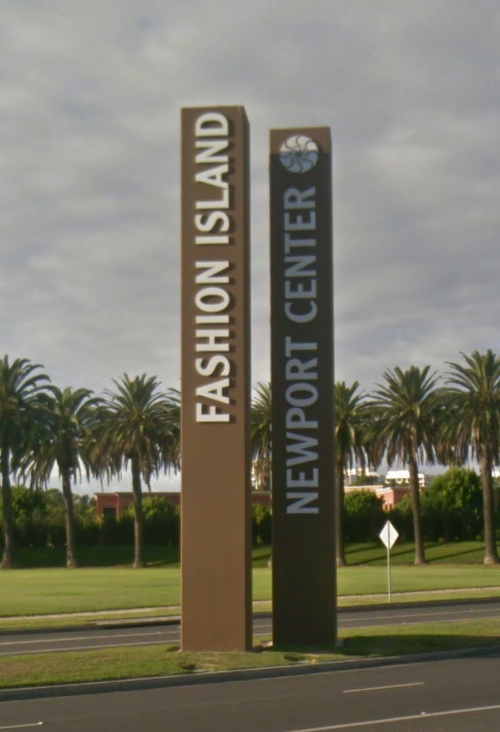
Untitled (Newport Center Monument) I, II, 2017, 43 x 4 ft each, Ruddy Oak and Bright White on substrate, installation image: gmaps
They also match the color and finish of the main signs at the East Coast Highway entrance, a pair of 43-foot-tall pylons installed in 1985. Which is also the first year The Irvine Company used the “sunwave” logo. Over time the text on the signs has changed to reflect the evolving brand distinctions between Newport Center, a massive, multi-use development, and Fashion Island, the vast mall at its center.
For their part, the Newport Center signs also exceed the 20′ height limit for pylon signs by 115%, but I presume they predated the creation of the code, and/or that no one will tell The Irvine Company what it can’t do in Newport Beach. Their letters are individually fabricated.
There are at least eleven other signs at other entrances to Fashion Island/Newport Center, but they’re more architectural than sculptural, with concrete plinths and stucco-finished capitals. Only the four signs on the ECH exhibit this rigorous, minimalist aspect.
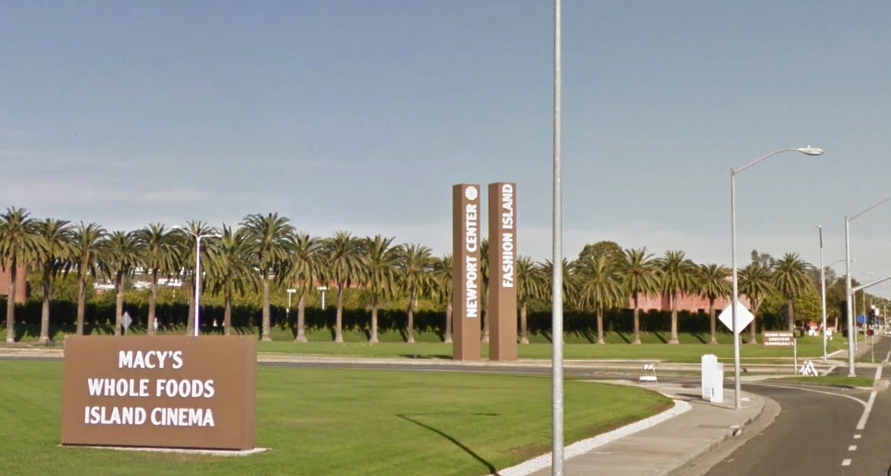
[l. to r.] Untitled (Newport Center Monument) III, I, II & IV, 2017, installation view, image: gmaps
Fashion Island was and remains a leader in the mall industry for experiential design. In an essay called, “The Archaeology of ‘Shoppertainment,'” Matthew Cochran and Paul Mullins wrote about RTKL/ ID8, a mall interior design company which worked on the Fashion Island Experience. They quote an RTKL brochure:
[Mall experience is] about storytelling. Great places tell stories, and people love to find themselves in those stories. Often this has less to do with the way a building or a district is assembled and more to do with how we read it…Experience is in the details. If a place tells a story, then the details of that place make the story interesting. The smallest elements-from manhole coves to water features-conspire to create a dynamic, authentically human environment.
What story do these signs tell? What authenticity do they conspire to create, with their approved colors from a gated community on a bluff? Can the gestalt of the minimalist object be achieved from your car, at speed, as you pass the mall, or do you have to turn in?
This ID8 quote, too, turns out to have more to do with how I read it:
What makes us linger, pause, sit and think? The building blocks of place probably have less to do with the buildings and more to do with the spaces between those buildings.
In 2002, the day they flipped the switch, architect Gustavo Bonevardi explained how he and John Bennett arrived at their solution for what became the Tribute of Light World Trade Center memorial:
We’re not reconstructing the towers in their original size, but the distance between the two squares of light is the same as the distance between the actual towers. So in effect, we’re not rebuilding the towers themselves, but the void between them.
Because I cannot look at the Newport Center signs, and their proportions, and their void, and not see the World Trade Center.
But maybe that’s just me. I invite you to visit, view, linger, think, and pause at this installation of new work and pursue your own authentic, dynamic, human experience.
Previously, unexpectedly related, c. 2002: On reading (between) the lines
On’s Location
Various Brief Notes From Los Angeles County Museum
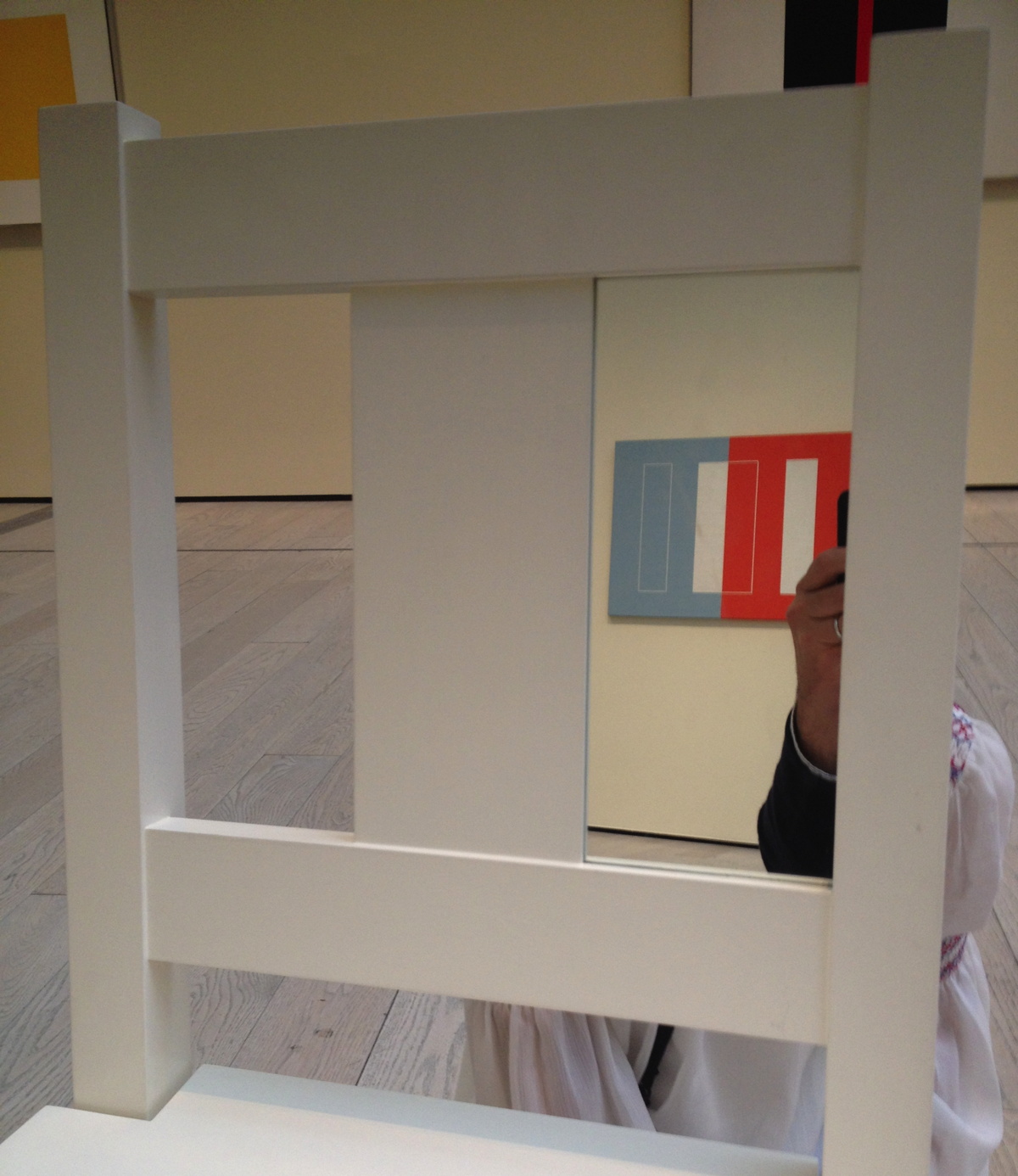
Just got back from a quick trip to Los Angeles. The John McLaughlin show is as transcendent as everyone said, and all the museums that didn’t take it are as clueless as everyone feared. The chairs are a bit twee, though, to be frank, but the sentiment is welcome. If I’d been alone, maybe I would have put them to longer use, but then, I also preferred standing right in front of the paintings. Too many paintings had frames that covered the edges; the subtly different painted edges were my absolute favorite part of the Phillips Collection’s McLaughlin. Otherwise, everything about McLaughlin and his work and practice is heartening, even though he’s chronically underseen.
The Picasso Rivera show was revelatory. Chris Burden’s Metropolis II is still great. Broad’s giant Serra Band is like a bunch of holding cells and not in a good way. Turns out you can screw up something that big. Which, we did not go in the Resnick Pavilion at all. Artists give unusual work to this museum; it really feels very local.
The Moholy Nagy show was a labyrinthine confusion in this version, but so much wonderful stuff, including all three of the “Telephone Paintings”. The label still says there were five. I guess I will need to look into that situation now.
Pearl Necklace (1967) by Robert Watts
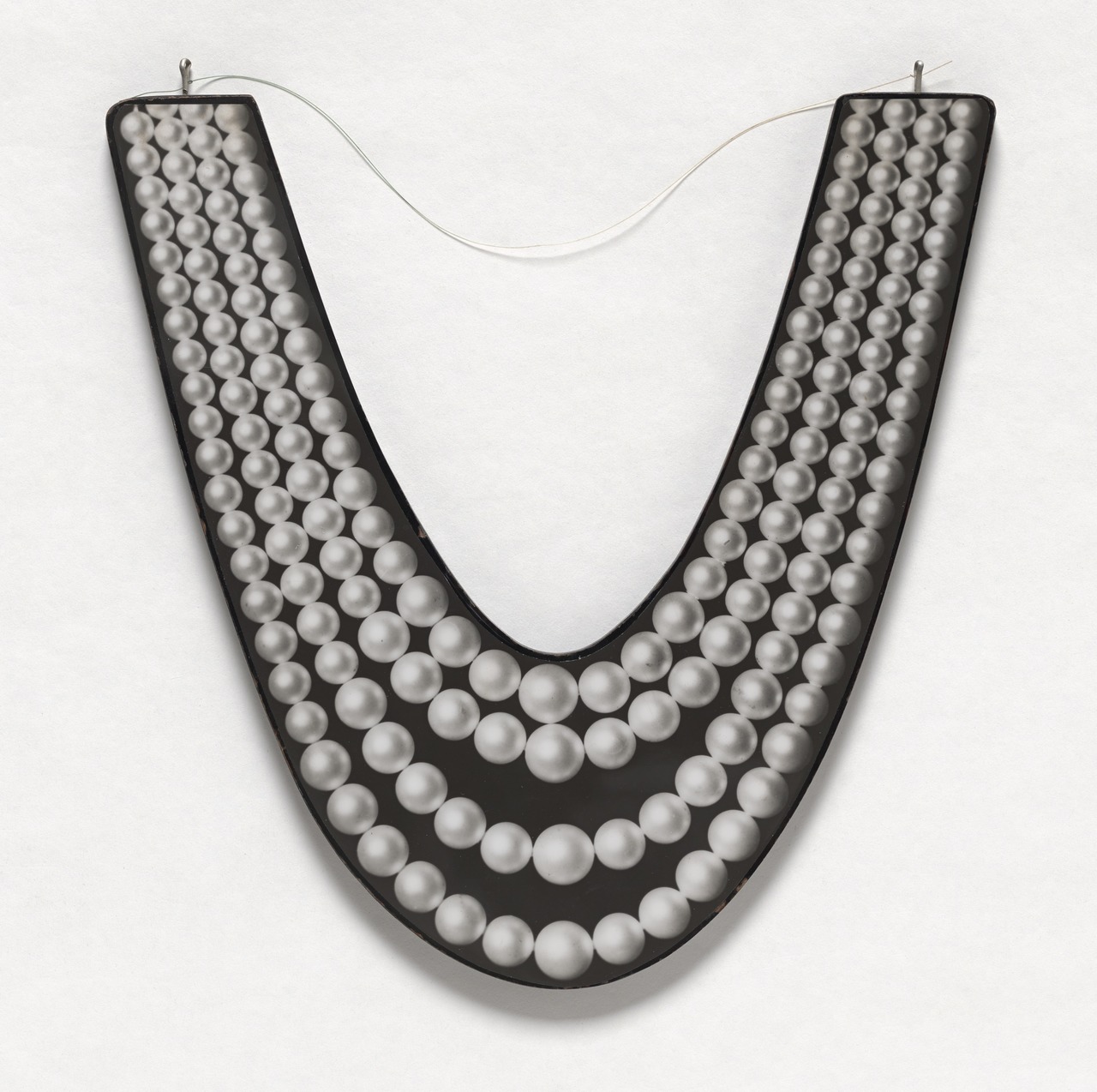
I looked at a lot of Robert Watts while researching and writing about his friend Aaron Kuriloff. I really liked it. MoMA has some very nice and interesting chrome Watts pieces on view right now in the 1960s hang of the permanent collection galleries, but I have never seen this in person. Pearl Necklace is a 1:1-scale photo mounted on wood. The wire makes me think it had to have been designed for wearing, which is awesome. In 1967 Kuriloff had his last show, of 1:1-scale photos of office furniture and equipment he called “photo-factuals.” He’d been making them for a couple of years, and I’m pretty sure he and Watts were up on/involved in each other’s work. I, for one, would like to know and see more.
Robert Watts, Pearl Necklace, c. 1967, acquired 2008 from the Silverman Fluxus collection [moma.org]
Which, yes, My dive into the history of Aaron Kuriloff is in the Spring 2017 issue of ArtNEWS [artnews]
Previously, related: More Aaron Kuriloff, Please
#exstrange: Curated eBay-as-Art-Platform
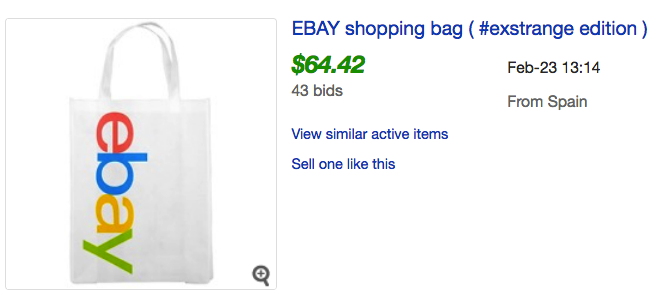
jodi, eBay shopping bag (#exstrange edition), screenshot: ebay
#exstrange is an art project of, on, and about eBay. Curators conceived and launched #exstrange by inviting artists to create “artworks as auctions” that use “the entire listing (descriptive text, images, pricing, and categories) as material to build the artwork.” Occasionally some of those artworks even involve objects.
Marialaura Ghidini and Rebekah Modrak began the #exstrange exploration, and they are involved in the website and book [forthcoming] documenting and discussing the project. But by its nature, #exstrange also exists-and eventually disappears-on eBay, as a hashtag/search term that is ultimately beyond the curators’ control.
There is no shortage of art on eBay, nor of conceptual stunts, often designed for shock or novelty that, it is hoped, will generate interest and a sale. While there are immediately appealing objects, too, like a stamped eBay shopping bag edition by the net collective Jodi, some of #exstrange’s most interesting works are designed to exploit the parameters of eBay’s system and the expectations of its users.

Joana Moll, Google trackers in North Korea official webpage, 2017, image: exstrange.com
In her listing Joana Moll pitched “Google trackers in North Korea official webpage” as “living proof of US colonization over the Asian country.” The opening bid was $30. But because the Barcelona-based artist used the US site, her sale was subject to US law, which prohibits trade of North Korean goods. And so the listing was canceled by an embargobot which couldn’t discern the nuances of selling a screenshot of a txt file showing Google Analytics code embedded in the DPRK’s (presumably homegrown) html. No problem, though, because the delisting is part of Moll’s piece.
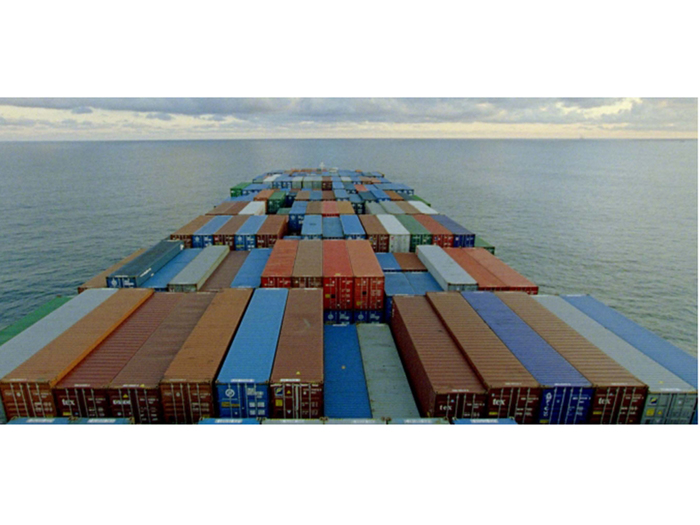
Lloyd Corporation, Bankrupt. Bulk Buy. Liquidation. Repossession #exstrange, 2017, exstrange.com
Lloyd Corporation, meanwhile, appropriated the texts and images from listings by a bankruptcy liquidation specialist, and sold inattentive bargain hunters boxes of junk that nevertheless literally met the listing’s descriptions and caveats. Don’t worry how it turned out, though: the angry correspondence unraveling the sale became part of the work.
As the project propagates, others are jumping in and glomming on. Whether the curator-controlled website follows the free-range hashtag or diverges from it remains to be seen. #exstrange could remain an esoteric label, or it could follow the arc of “eames era” as a genre-specific default search term that dilutes its specificity to homeopathic levels of uselessness. In the mean time, I will definitely be courting some of those conceptual art bidding’ eyeballs by throwing it into my title description of my next eBay sale,. To paraphrase Rauschenberg, “this is an #exstrange if I say so.”
#exstrange, co-curated by Marialaura Ghidini and Rebekah Modrak [exstrange.com via someone one twitter, thanks! probably regine/wmmna]
Previously, related: eBay Test Prints: DO NOT BID OR BUY
DO NOT BID OR BUY Meets DO NOT LIST OR SELL
We’re Not All Chris Burden Now
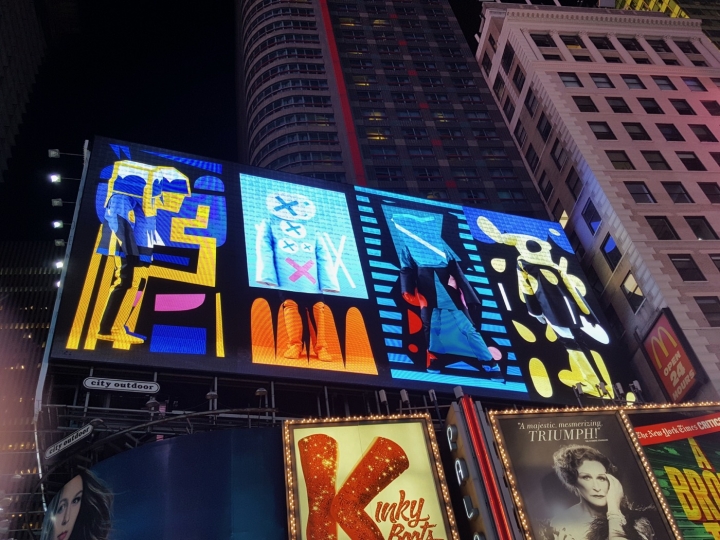
Brian Bress, Consonance and Dissonance in Four Parts for Times Square, in Times Square for Public Art Fund, image: hyperallergic
Recently Seph Rodney wrote for Hyperallergic about the Public Art Fund’s Commercial Break series, which places “interruptions” by 23 artists within the advertising programming of large-scale public screens in NYC. The project ended last weekend, but from Rodney’s account, you probably wouldn’t have noticed either way:
the project’s images are not so much a break as a pause — in some cases, by my count, a four-second interlude in which I’m not even sure what I’m looking at and not sure it’s all that different from what came before and what comes after.
It turns out to be difficult for an artist to create a successful art experience entirely within the visual context of a cacophonous commercial cityscape.
Rodney cites several historical antecedents, including Marilyn Minter and Chris Burden’s TV commercials, Creative Time & MTV’s artist spots in the 80s, and PAF’s own Messages To The Public (1982-1990), which inserted artist messages on a billboard in Times Square. Oddly, there’s no mention of Creative Time’s 59th Minute (2000-07), which did the same thing on the same spot, but with the new screen sponsor, Panasonic.
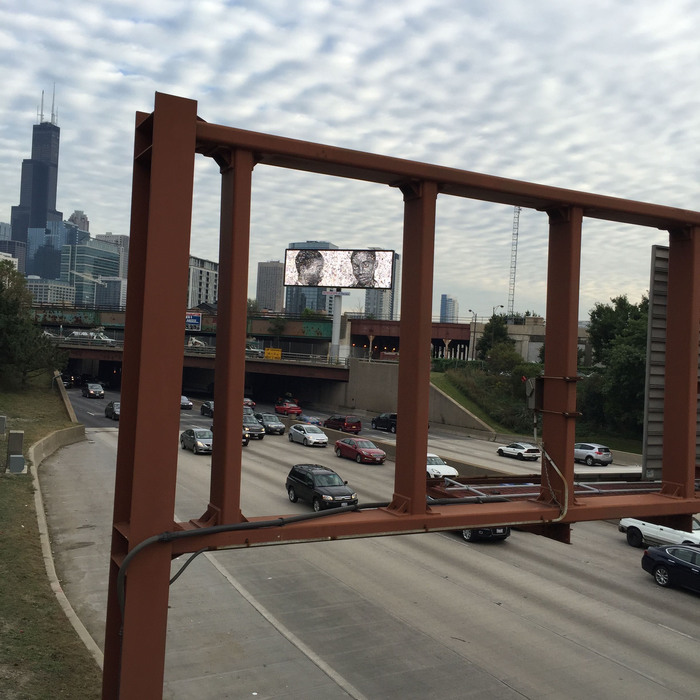 Vik Muniz, George Stinney, Jr. (2016), seen on a billboard for OVERRIDE, Expo Chicago, image: Meg Handler/Artnews
Vik Muniz, George Stinney, Jr. (2016), seen on a billboard for OVERRIDE, Expo Chicago, image: Meg Handler/Artnews
Context is hard anyway, but advertising is especially unforgiving. It all reminded me of the problematic billboard Vik Muniz made last year for Override, the public art program of Expo Chicago. Dushko Petrovich dug into it for Art News. Everyone who ever contemplates making or curating ad-related art for the public sphere needs to read about this mess.
Expo Chicago had invited several artists to submit images of works to be broadcast in rotation on electronic billboards around the city during the art fair. Muniz’s George Stinney, Jr. was a still photo from a video piece he’d made in 2015 that told the story of the youngest person ever executed in the US. That moving backstory was lost, though, to passersby who just saw the mug shot of a 14-year-old African American boy flash across a billboard.
None of the Override works were presented with any kind of introduction or identification to distinguish them as art. This lack of framing allowed the other works their surprise and titillation. But with the Stinney mugshot, mystery presented a problem: if viewers didn’t know it was art, how were they supposed to know it was a critique? What did it mean to see this image without preparation or context?
Thousands of random people were seeing it all over Chicago, but there was no way to identify these unwitting viewers, much less talk to them.
Well, Facebook. Dushko spoke with Chicago residents who were baffled, disturbed, and angered by the Stinney image; it didn’t help, but it’s worth noting that this sounds very close to Muniz’ own reaction when he first discovered Stinney’s story.
In 2010 I said that Google’s nascent AdWords-style market for buying TV commercials should be a boon for artists. “We’re all Chris Burden Now,” I said. Well, I was wrong, and it’s probably for the best that we all didn’t take my advice, because the blunders would have been off the hook. But if you’re going to make ad-related public art, just give it some thought, mkay? It’s tricky in the best of times, and these are not those times.
Aiming to Disrupt Ads in New York City, Artworks Instead Blend In [hyperallergic]
In the Context of No Context: A Digital Billboard in Chicago Raises Questions About Art in the Public Sphere [artnews]
Previously, related: We’re All Chris Burden Now
Starting With Chris Burden’s TV Ad, Through The Night Softly
I Just Remembered I’d Wanted [To Make] John Cage’s Table
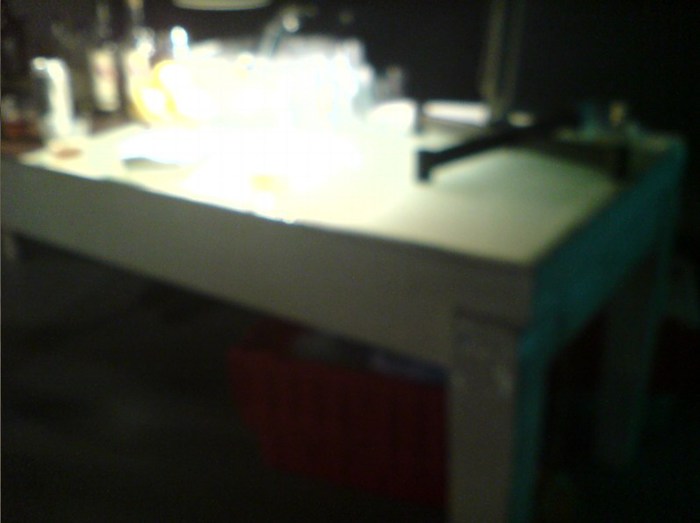
I am not sure why, but I just remembered that I once wanted John Cage’s table in a totally non-venerating way, or, barring that, that I wanted to make it, and had thus recorded the score [sic] for the table on a bar napkin at one point.
Previously: Scoring John Cage’s Table
Why Not…
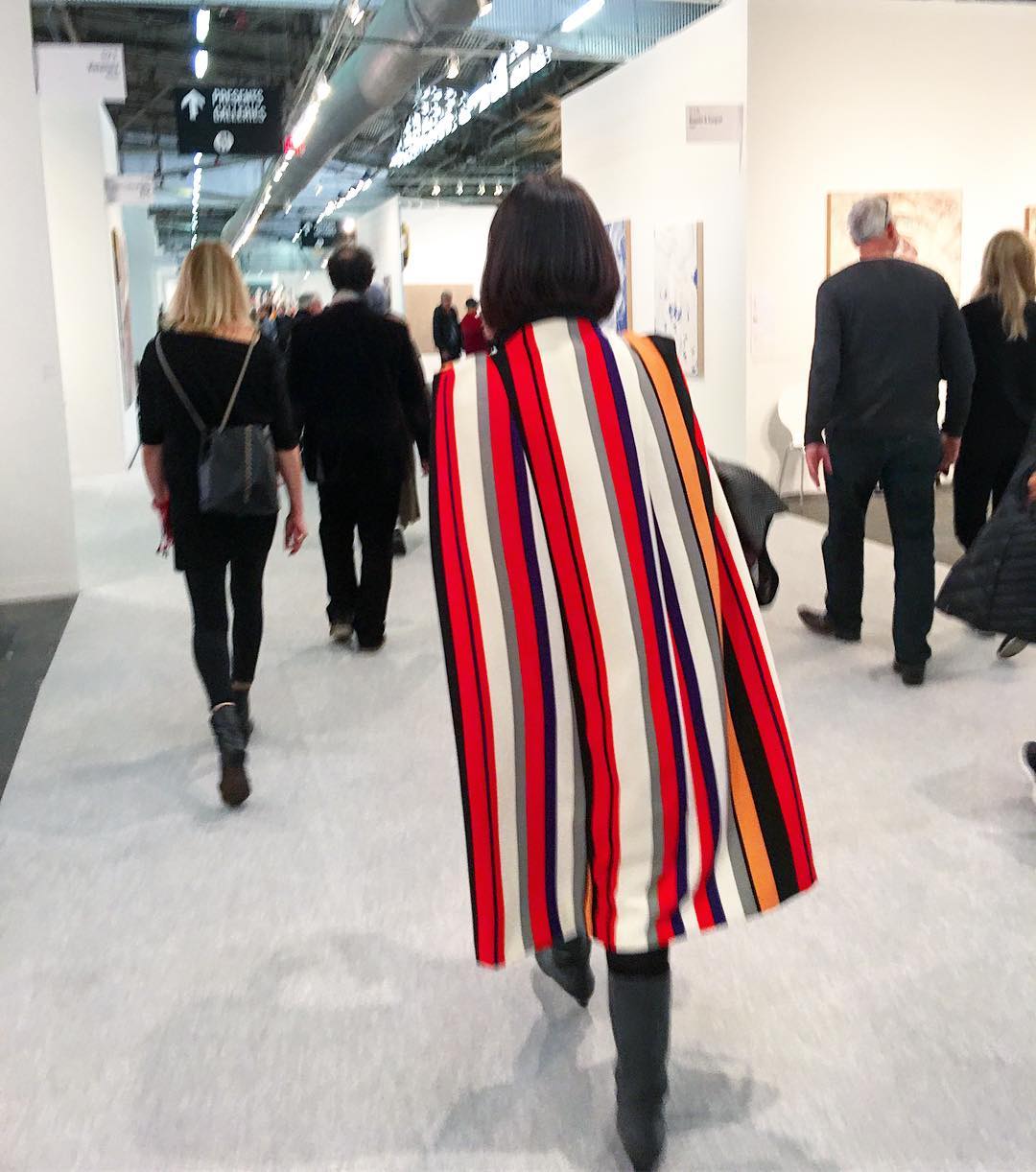
“@klausbiesenbach recommended dress code for #armoryartsweek comments please”
throw your bought-in Fredrik Vaerslev over your shoulders like a cape and shop it around the pier in the afternoon?
Untitled (Picture Light), 2017
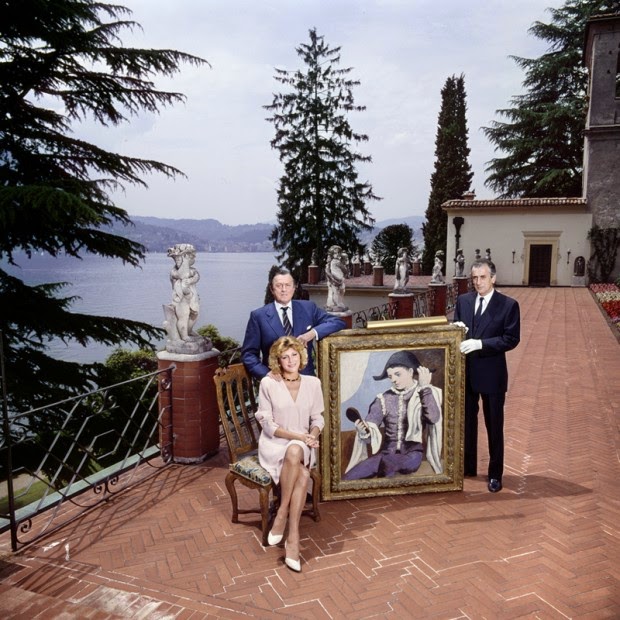
Untitled (Picture Light), 2017, picture light, gilt frame, Picasso, installation view, 1989. image: Chema Conesa via The Art Newspaper
In 1989 Baron and Baroness von Thyssen-Bornemisza brought a dining chair out to the terrace of Villa Favorita to sit for a portrait by photographer Chema Conesa. The Baroness sat. The Baron stood, with his right hand on his wife’s shoulder. Someone seems to have had the idea to add Picasso’s Harlequin with a Mirror to the composition.
It it not clear where the 1923 painting was hanging, but it was. A white-gloved manservant apparently took it off the wall and marched it outside. He holds it on the right corner as it rests on the bare brick ground. The Baron stabilizes the other corner by resting his left forearm on the frame. The brass picture light is still attached.
The Baron bought Harlequin with a Mirror in 1979. X-rays show that Picasso originally painted a self-portrait, possibly as a Cupid/Eros combo, before replacing his face with the mask-like stare of the harlequin. William Rubin and Pierre Daix linked the early state of the harlequin to Picasso’s 1923 frustrated infatuation with Sara Murphy, of the Cap d’Antibes Murphys. The series marked the end of Picasso’s so-called Classical phase. It is currently unclear when, where, or why the Baron bought it, though.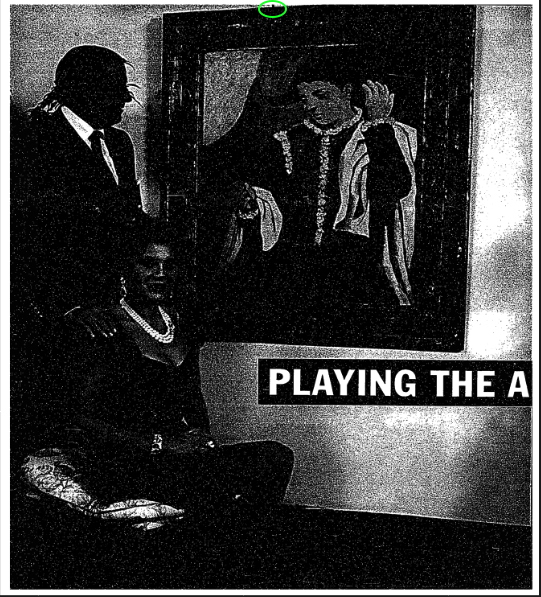
The Thyssen-Bornemiszas at home in Madrid with Harlequin with a Mirror and possible picture light detail, 1992, image via NYT
By 1992, the Thyssen-Bornemiszas had decamped to Madrid, anticipating the opening of the Museo Thyssen-Bornemisza across the street from the Prado and Reina Sofia, to which they had loaned (or rather, rented) more than 800 works, not yet including Harlequin. From the opening of a NY Times Magazine profile:
Baron Hans Heinrich Thyssen-Bornemisza is pouring himself another drink in front of a Picasso on the living room wall of his Madrid mansion. He is making the point that he has always been a tough businessman, the kind who won’t let anything get in the way of a good deal.
From the Baroness’s posture to the Baron’s hand, to the Harlequin photobomb, the Times’ image lacks only an art handler to complete its homage. A tiny black spot at the edge of the page gives me hope that the Harlequin made the trip from Lugano to Madrid with his picture light intact. It did not, however, survive the trip into the Museo.
So whether it overlooks Lake Lugano or the Paseo del Prado, this sculptural situation of a picture light on a Picasso sitting nonchalantly and unmediated on a terrace is exceptional, and will likely never occur again. So this work probably exists only in retrorsum in memoriam. Still gives me chills, though.
[May 2024 update: I was thinking of this work again, still marveling at it, and decided to reach out to El Pais photojournalist Chema Conesa, who made this image. Before doing that, though, I found this lecture he gave in May 2023, where he talks about the extraordinary and mundane circumstances that led to this scene.]
Pablo Picasso, Harlequin with a Mirror, 1923 [museothyssen.org]
Playing The Art Game For High Stakes [nyt mag, 04 Oct 1992]
